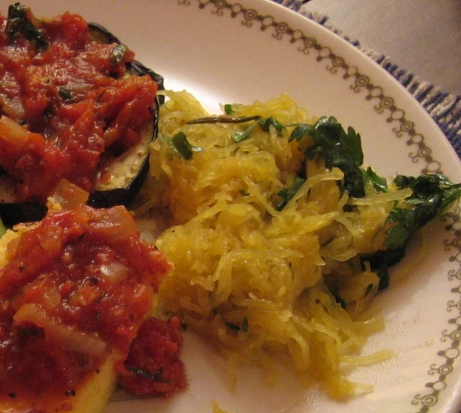
This recipe was extremely simple, and as far I’ve seen is the only recipe in The Book that calls for the use of a microwave. Basically a spaghetti squash is microwaved, the strands are pulled out and tossed with a compound butter made with garlic, cumin, coriander, cayenne, and salt. Top with a bit of fresh cilantro and you have a simple side. This dish tasted good because spaghetti squash taste good, but I’m not sure the compound butter was the best possible pairing for it. The title of the recipe is a bit of a misnomer, there’s nothing all that Moroccan about the spices, in fact they read like basic Tex-Mex cookery. I suppose it’s the coriander that’s supposed to recall North Africa?
The dish probably would have been better if it had gone more Tex-Mex. A splash of lime juice would have added some welcome acidity, and replacing the cayenne with chopped fresh jalapenos would have added more dimension than the straightforward heat of cayenne. The ground coriander was the least appealing part of the butter, it was only 1/2 teaspoon, but a little coriander goes a long way. I found it a bit distracting, and out of balance with the other flavours. The recipe could also have cut back on the butter without anyone missing it.
All of those issues are easily fixed, and the basic method of preparing the squash is great. All I did was poke the squash with a fork, then microwave on high for ~7 minutes per side. The instructions in The Book are for an 800 watt microwave, and I think mine is 1100, so it cooked a bit faster. The quicker cooking didn’t seem to have damaged anything, and you’ll know when it’s done when the squash gets soft, so the exact time doesn’t really matter. A little bit of juice flows from the holes you pricked, and the sugars quickly caramelize making the outside quite sticky. I didn’t put the squash on a plate, and the microwave try was a bother to clean.
The strands of squash come out nicely separated, and whole. They have a great texture, and they’re inherently fun to eat. My squash was sweet, deeply flavoured, and vibrantly yellow. I don’t think I’d toss it with this particular butter again, but from now on my spaghetti squash are going in the microwave.
3 replies on “81. Spaghetti Squash with Moroccan Spices p.581”
I remember being somewhat surprised myself, when I first attempted spaghetti squash, to find that the only preparation method listed in Joy was the microwave — but it does work a treat, doesn’t it? It makes me wonder how people used to make spaghetti squash before microwaves were ubiquitous. And is the microwave so much better than the older methods that it’s just not worth talking about them anymore?
The other method listed in the book is a 350 degree oven for 1 – 1 1/2 hours. I guess that’s the antiquated method. I suppose there’s a risk of it drying out more than you’d like in the oven, plus it takes much much longer.
Most of the people I know of who don’t have microwaves are principled (some would say snooty) foodies. I think they’re fairly cheap, and useful for reheating leftovers, so why not have one? They are big, and don’t play well with apartment kitchens though. I could easily go without one, but I won’t be giving mine up any time soon.
Since they’re nearly ubiquitous, it’s nice to see them called for from time to time. Recipes are notorious for calling for ridiculous unitaskers like paella pans, and madeline tins, but they try to pretend that the versatile microwave doesn’t exist.
Writing this post got me in the mood for spaghetti squash again. I followed the microwave directions, and it turned out perfectly. I tossed the squash with olive oil, goat’s milk feta, and kalamata olives. The squash was delicious, and the feta was great. I don’t think was destined to become one of life’s great flavour combinations though.